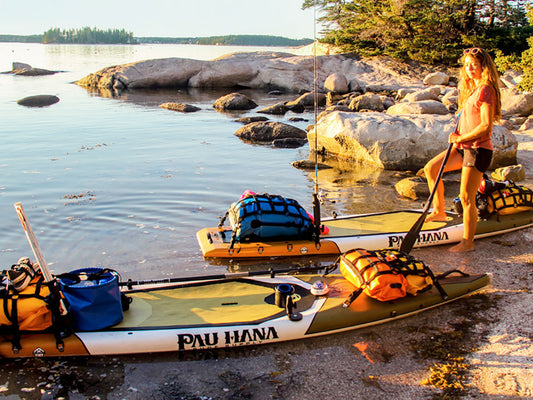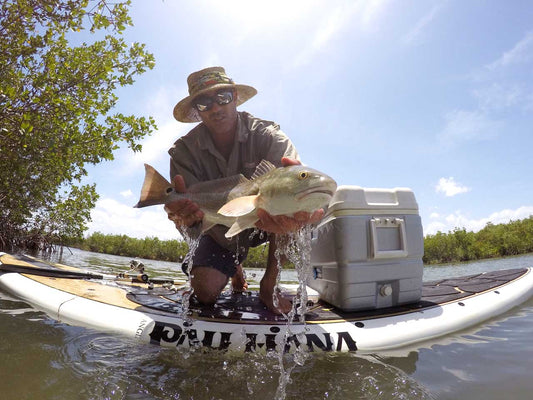There’s nothing quite like standing on a paddleboard and feeling the water slide past the board beneath you - but that easy, relaxed glide doesn’t happen by accident. Good technique is what turns those early wobbles into confident strokes, effortless turns, straight lines and joyful time on the water. Whether you’ve just unwrapped your first board or you’re ready to refine your skills, learning a few fundamental techniques will completely change your paddling experience. Let’s walk through the essential techniques every paddler should know, plus a few intermediate moves for when you're ready to level up.
1. Getting Comfortable Standing and Balancing
Balance is the foundation of paddleboarding, and it starts long before you take your first stroke.
Start Somewhere Calm
Flat, sheltered spots - like lakes or quiet bays - give you space to focus on your body instead of fighting wind, chop, or passing boat wakes.
Find the Sweet Spot on Your Board
Start by kneeling in the middle of the board to feel how it moves. When you're ready to stand:
- Place your feet on either side of the carry handle
- Keep your feet shoulder-width apart and parallel
- Stay centred on the board- too far forward or back will throw off your balance
Soften Your Knees
Locked knees = instant wobble.
Bend them slightly and switch on your core so you can absorb the wobbles. This also lets your body react quickly when the water shifts under your feet.
Look Up, Not Down
Your board goes where your eyes go. Pick a point on the horizon and keep your chest lifted - it’s amazing how much easier balance becomes when you stop staring at your toes.
2. The Forward Stroke: Your Bread-and-Butter Technique
The forward stroke is what keeps you moving - and doing it with good technique makes paddling smoother, faster, and far less tiring.
Reach and Plant
Extend the paddle forward and set the blade fully into the water. Most blades are angled, so make sure the angle faces away from you.
Keep the Blade Close to the Board
Pull the blade straight back through the water along the rail (edge) of the board. A narrow stroke keeps you gliding in a straight line.
Rotate, Don’t Just Pull
Beginners tend to use their arms like they're rowing a small boat. Instead:
- Rotate from your torso
- Engage your core
- Let your shoulders and back help with power
This spreads the work across your whole body and dramatically reduces arm fatigue.
Finish at Your Feet
Once the paddle reaches your heels, lift it out cleanly and return to the start of the stroke - dragging it too far back slows you down.
If your board starts drifting off course, simply switch the side you are paddling on.
3. Turning Techniques That Make Your Board Feel Alive
Once you’re comfortable going straight, it’s time to learn how to turn like you mean it.
Backward Sweep
This stroke is great for quick pivots or tight spaces.
- Place the blade near the tail
- Sweep in a wide arc toward the nose
- Rotate your torso and keep your knees soft
Your board will spin toward the opposite side of the stroke.
Forward Sweep
This stroke is useful when you want a gentler, more controlled turn.
- Plant the blade near the nose
- Sweep outward and back toward the tail
The wider the sweep, the stronger the turn.
Reverse Stroke (Your Braking System)
Perfect for slowing down or stopping:
- Plant the blade at your feet
- Push the water forward
- Your board will slow or stop depending on how hard you pull. If you need more braking, swap sides and repeat
This is especially helpful when approaching shore, docks, or other paddlers.
4. How to Fall (Yes, It Matters)
Falling is all part of the fun - as long as you do it safely.
Fall Into the Water, Not Onto the Board
Your board is solid. The water is soft. Choose wisely.
Keep Your Paddle With You
It floats… away. Fast. Holding onto it saves energy (and save the embarrassment).
Always Wear a Leash
Your leash keeps the board close, even when the wind picks up. Losing your board in chop can escalate really quickly.
5. Handling Wind and Choppy Conditions
Even on calm days it can get breezy, so knowing how to adjust to the changing conditions keeps you safe and in control.
Drop to Your Knees
Lowering your centre of gravity = higher stability. It’s also easier to push through the wind.
Use Short, Quick Strokes
Long strokes are inefficient when paddling against the wind or chop. Short bursts help to maintain momentum.
Shift Your Body Angle
Turn slightly sideways to reduce your body surface area the wind hits. It’s a small tweak that makes a big difference.
Plan Ahead
If you're starting with the wind at your back, remember: coming home will be harder. Paddle into the wind first whenever possible so its an easier return when you’re tired.
6. Advanced Techniques for When You’re Ready to Level Up
Once you feel confident with the basics, these moves open up a whole new world of control and agility.
Cross-Bow Turn
A sleek, efficient turn used by experienced paddlers:
- Paddle on one side
- Bring the blade across the nose to the opposite side
- Sweep outward in a smooth arc
This technique spins the board surprisingly quickly and feels incredibly satisfying once you nail it.
Pivot Turn
A favourite in surfing, racing, and quick manoeuvring:
- Step one foot back toward the tail
- Let the nose lift slightly
- Use sweeping strokes to spin your board on its tail
This move requires a lot of practice - and yes, you’ll fall a few times learning it - but mastering it is a turning point (pun absolutely intended).
THE TAKEAWAY
Great technique doesn’t just make you a better paddler - it makes every session more enjoyable, more efficient, and more empowering. Once you understand balance, proper strokes, safe falling, and how to read conditions, the water opens up in entirely new ways.
As you build confidence, you’ll find yourself exploring farther, trying new manoeuvres, and paddling with a sense of ease that only comes from practice.





